How to cover strawberries for the winter - practical recommendations and tips! Is it possible to cover roses for the winter with sawdust?
November is approaching - it's time to arrange the winter hut. Do I need to cover plants for the winter? - Alas, it is necessary.
Neither you nor I were satisfied with the original inhabitants of our harsh climate in our garden. You have to pay for such exotic things as roses, lavender, boxwood, and grapes - you have to spare no time and effort in covering the plants for the winter. You can, of course, take a risk and leave it as is, but it would be a shame to miss out on your favorite bushes and flowers in the spring. IN best case scenario, they will lose a significant part of the crown, in the worst case, they will not wake up at all.
What plants need to be covered?
First of all, for guests from warm countries or places with mild winters, these are lavender, boxwood, and grapes. Not all types of sage and thyme (thyme) survive our winters without loss; you need to experiment with them. Clematis and most roses are also at risk. We also plant heat-loving cypress trees - without winter shelter their crown is damaged.
Container plants - lemons, rosemary, etc. you have to bring it into the house altogether. Even the thickest cover cannot save these southerners on the street.
Saplings in pots, even the most winter-hardy ones (currants, Siberian cedars, spruces, pine trees) must be buried level with the ground, flush.
Most thujas do not mind our winter cold, however, young thujas, up to 5 years old, are still better to be insulated for the winter.
Tall thujas, slender junipers and winter-hardy cypress trees are recommended to be tied with stockings or wrapped with lutrasil so that their branches do not crumble or break under heavy wet snow. I must admit, I don’t do this for aesthetic reasons: we all year round We live in a village, and we brought in conifers so that there would be some kind of greenery in the winter. That's why old stockings on junipers don't suit me. But I have the opportunity to shake the bushes after a snowfall. After the famous Moscow catastrophic icing, she even heated pine trees, freeing them from ice using the Veterok electric heater.
Risk factors:
Snowless (“black”) frosts, severe and prolonged winter cold and, oddly enough, March bright sun. The sun against the background of white snow damages tender young conifers. You can save them by covering them with non-woven material or installing a screen on the south side.
Preparing plants for winter
Preparation for wintering is important not only for heat-loving plants. Even the original inhabitants of the Middle Zone may not tolerate a harsh winter well. If you apply fertilizer, stop feeding nitrogen early, in late summer. Nitrogen promotes the growth of green mass, but by autumn the ripening of shoots is more important. For some perennials, it is recommended to remove flowers and buds by the end of September. Adding a thick layer of humus under the bushes will not only improve the soil, but will also warm the roots in winter. After all, humus is both a fur coat and a stove.
What and how to cover
The method of covering depends on the plant: its height, winter hardiness, susceptibility to mold, etc. I will outline the general principles.
Step 1. Remove from the support and lower to the ground: roses, clematis, grapes.
Step 2. Cover the bushes with oak leaves. Oak itself does not rot, and prevents the spread of rot and fungal infection. We have our own oak trees growing on our property, and nearby there is a whole oak grove. I visit the grove with a lot of plastic bag, where I densely stuff fallen leaves. If it’s difficult with oak trees, you can fill it with dry leaves of other trees, sawdust or even dry peat.
Step 3. Cover the mountain of oak leaves wooden box. This is ideal. There are not enough boxes for all plants. Then they get to work cardboard boxes, plastic buckets, multi-layer lutrasil, pressed down with boards - any available material, for which your imagination is enough. What is not recommended to use is plastic film, under which there is a haven of all kinds of rot and mushrooms.
I saw how some gardeners use spruce branches for winter shelter. I am against this method for ideological reasons - forest trees should not pay for our love for the exotic.
Step 4. Optional. When the first snow falls, it is advisable to heat it onto covered beds. The plants will be warmer.
When to cover for the winter
The question is complex. We have to guess the weather. Cover it too late and the plants will freeze, too early and they will rot. Most of all, you need to be wary of prolonged snowless, “black” frosts. As a rule, I cover the plants in the first half of November, with the onset of stable frosts.
When to open plants in spring
It is equally important to open the plants in time. Again, if you open it too early, the March sun will burn the bushes weakened by hibernation; if you miss the moment, you will create a haven for infection in the dark, warm, damp depths of the covering material... I open it when the snow has mostly melted. And immediately after - a revitalizing fertilizing with nitrogen (a box of urea in a bucket of water or just lightly sprinkled under decorative bushes).
It can be a shame when a plant that seems to have weathered the winter well, so tender and green under a layer of oak leaves, quickly dies when exposed to the open air. This happens. That's life.
On the other hand, sometimes some clematis just doesn’t want to wake up in the spring. Other buds have already gathered, but this one did not come out of the ground. Don’t rush to put an end to it or take its place with another plant. He may still wake up very late. And this happens. Such is unpredictable life.
Good luck and a snowy winter to you and your plants!
Please note this:
 |
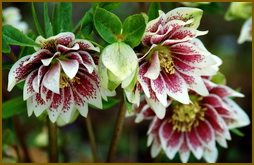 |
 |
| All about garden plants | ||
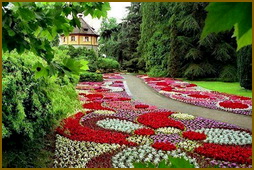 |
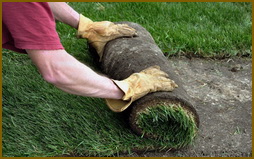 |
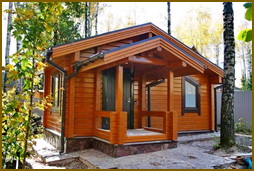 |
Sweet, aromatic and everyone's favorite strawberry is the queen of the garden. If you can imagine a plot without blueberries, raspberries, then you cannot imagine it without strawberries. Every zealous owner tries not only to grow strawberries according to the technology for harvesting big harvest, but also strives to cover the berries for the winter. Handy materials, sawdust and leaves from trees are used. But how to properly protect berries from bad weather? What to use: spunbond (agrofibre), covering material in the form of polyethylene film? There are answers and they are here!
Save strawberries, or why cover the berries for the winter
Many gardeners believe that by covering strawberries, they only save them from the cold. But this is not entirely true. Yes, the beneficial microclimate under the shelter allows both the bush itself and the roots, which are located close to the soil surface, to not freeze. Such care will allow us to collect next year big harvest.
Of course, strawberries will do well under the cover of snow. But its thickness must be at least 30 cm - and throughout the entire period. The weather in our region cannot boast of such consistency, so it’s worth helping your favorite berries survive the winter.
But the covering material saves your favorite berry from:
- frosty winds. They are the ones who can not only harm the plant, but also erode the top, most nutritious layer of soil;

Mulching will protect strawberry bushes from cold and drying out of the soil
- drying out/high humidity. In the first case, it retains moisture when the frost has not yet subsided, but the spring sun warms it up; in the second case, it does not allow rain to fall on the bush. autumn period;
- mechanical damage, trampling by pets. This is especially true for young plants planted in winter.
Understanding why it is worth covering the berries is half the battle. It also includes the choice of materials and plants, as well as - correct timing. The second half is preparing the plants for shelter and wintering. After all, only by doing everything consistently and without forgetting anything, you can get excellent harvest berries for next year, healthy queen cells and powerful young plants.
Procedures preceding shelter, or do everything one by one
Covering strawberries for the winter by choosing one material or another is not a problem. However, before this, it is worth carrying out a number of actions that will help the plant overwinter and enter the new season full of strength.
With the onset of autumn and before stopping watering the berries, you need to:
- feed, that is, saturate it with the necessary macro- and microelements so that the plant can withstand winter frosts;
- free the bushes from diseased, spotted/blackened, dry or torn leaves. It is also worth cutting off all the tendrils if it is not a mother plant that is left for the winter;
- loosen the soil after stopping watering. This will help the roots breathe, water - faster and easier to deliver nutrients;
- rid the garden bed of weeds;
- mulch the root collar.
And after that - start sheltering, keeping an eye on the air temperature!
Attention! You can cover the berries only after it has been covered both day and night. minus temperature, from -4ºС to -8ºС. It is during this period that it is worth “wrapping up” the beds with strawberries, because if you do this earlier, you can get a ripe plant, and later - a frozen one.
Briefly about the important things, or how to insulate the garden bed
Many owners do not rely only on plastic film or spunbond, but also use shelter from plants and leaves fruit trees, other materials. Such a layer undoubtedly provides optimal temperature and humidity conditions for the bed. However, it is worth knowing what to use as a cover for the berries, and what to avoid.
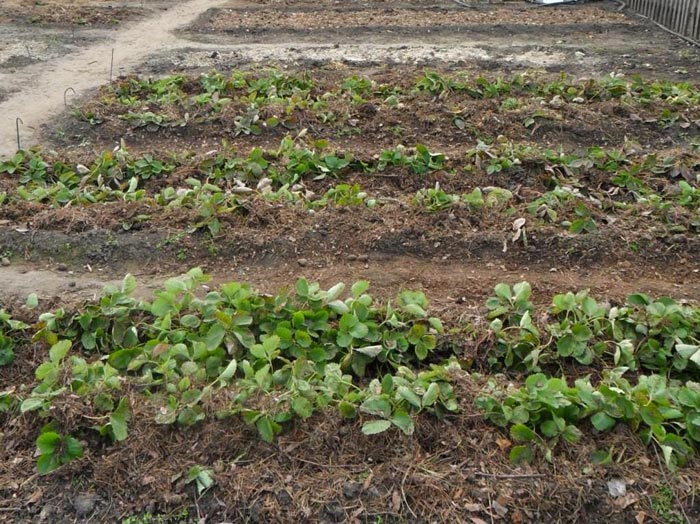
Shelter for strawberries from dry plants
The strawberry bed can be filled with:
- dry leaves of fruit trees if you are sure of their safety;
- sawdust or shavings. However, they will need to be removed as early as possible in the spring - they acidify the soil;
- stalks of corn, peppers and even. In this case, it is worth spreading poison on top to prevent mice that might come and feast on the vegetable plants.
Attention! You can use moss, as well as branches of spruce trees. It is worth laying the material on top of the bushes so as not to break or damage the plants.
Covering material for beds with strawberries: what to choose
Not so long ago there was no alternative: plastic film and that’s it. Many people used pieces of film, covering their beds, placing broken bricks along the edges or sprinkling them with earth. This material wear-resistant, not afraid of minor mechanical damage like spunbond, for example, it can be reused. But unlike agrofibre, the bed does not “breathe” under the film, although the temperature and humidity indicators are almost ideal.
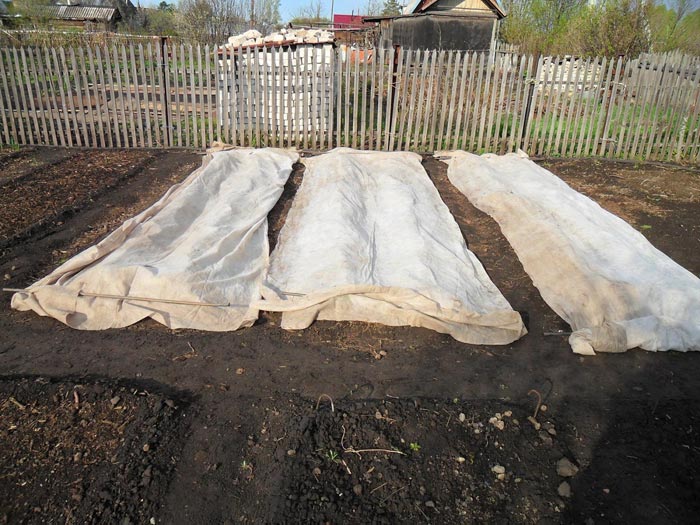
Preparing strawberry beds for winter
The best option when using PVC film as a covering material is the air-dry covering method. It is more labor-intensive than usual (when covering the bed on top of the bushes), but in this case the plants will feel great. For such a shelter, a mini-greenhouse is created in the garden bed, that is, arcs or supports are installed on which the film is stretched. Light penetrates inside perfectly, air circulates, and heat is retained!
Attention! Don't forget to remove the film from the bed early spring without waiting for stable heat. Otherwise, the plants will simply escape!
But if you are an innovator and not a conservative, you can use spunbond (). It can be purchased in a roll of a certain length and thickness. The last indicator will “tell” how many degrees of frost the berry will withstand.
Agrofibre will provide:
- creating an excellent microclimate inside the garden bed;
- maximum warmth;
- the possibility of watering and fertilizing through the canvas in early spring;
- a rich harvest that you will reap 14 days earlier;
- ease of operation, care and storage, service life - 5 seasons thanks to Strong-2-Edge technology or similar.
The decision is yours. Now you know how to prepare beds with strawberries for winter, what material to cover and how to do it correctly. You know and are not afraid that the garden bed will freeze. You are confident in the harvest!
Many gardeners panic if, immediately after purchasing seedlings, winter suddenly begins and the soil is covered with a layer of snow and ice. What to do with seedlings fruit crops, where can I put them, how can I preserve them so that they don’t die? Now we will tell you about all this. As is known, biologically the roots of various fruit crops, in particular pome trees, can develop freely in the soil if its temperature is only about three degrees above zero.
It has been established that a significant proportion of nitrogen in the soil is concentrated in humus, it contains more than 5% nitrogen. Naturally, the thicker the layer of humus, the greater the amount of nitrogen, therefore, plants feel better in such soil. Only one percent out of five that is in the soil is a mineral compound, and therefore available to plants. Consequently, even in the presence of a thick layer of humus, additional fertilizing is necessary for plants, although in lower doses.
Mushroom pie with kefir in the oven is a simple pastry that needs to be prepared in the fall, coming from the forest with a basket of forest gifts. Mushroom pie with kefir is incredibly simple; the most labor-intensive part of its preparation is boiling the mushrooms. Such jellied pies can be prepared not only with forest products, but also with meat, chicken, regular boiled sausage or frankfurters. By the way, nothing prevents you from adding any of the above products to this recipe, it will only turn out tastier.
Pruning is a word that scares many, and some of the owners personal plots they simply ignore pruning, removing only dry and broken shoots. Others, on the contrary, take up pruning too zealously, having read only a few articles on this topic and immediately make a whole bunch of mistakes. Let's figure out the mistakes today. Let those who are afraid to once again take up a pruner or garden saw learn from the mistakes of others so as not to make their own.
The tradition of making jack-o-lanterns comes from the custom of making lanterns to help lost souls find their way to purgatory. After many centuries, the Jack-o'-lantern has become an indispensable attribute of the Halloween holiday, and funny faces peek out from everywhere at the end of October, scaring away evil spirits. All you need to make a lantern is a beautiful orange pumpkin correct form, knife and spoon. For illumination, use a regular candle or an electric flashlight.
Onions and garlic are mystery vegetables; they leave a bad breath; it’s unlikely that anyone will be able to eat them just like that, taking an onion head and simply chewing it, as well as garlic, clove by clove. But, nevertheless, these vegetables are present in every dish, every salad, and what would a kebab be without aromatic onion rings? And of course, we should not forget about the medicinal benefits of these vegetables. Today we will try to talk about how you can preserve onions and garlic at home.
All efforts in November should be aimed at proper preparation garden for winter. Continuing to insulate plants and clean up the area are the most important tasks, but it’s time to introduce constant monitoring into your calendar to identify some problems. Attention with garden plants is slowly switching to the indoor collection. And the successful alternation of the phases of the Moon will allow you to find time almost every day to work with plants and for organizational troubles.
One of the most spectacular indoor grasses, Oplysmenus or Ostyanka, is a true exotic. This plant, originally from the distant Green Continent, surprises with both its growth form and the beauty of its variegated leaves. An atypical member of the cereal family, this plant is not for everyone. Oplismenus needs regular renewal and is sensitive to humidity. But it is so modern and daring in appearance that it quite rightly claims to be an indispensable indoor plant.
Soup with pumpkin, beans and pork ribs is a tasty, rich and thick first course, which is best prepared in late autumn or winter, when the harvest is harvested, it’s cold and uncomfortable outside, you want to warm up and eat something hearty. You can take any ribs - pork, veal, lamb; the cooking time will vary slightly, but not significantly. Young beans are tender, they do not need to be soaked or cooked for a long time, they will cook at the same time as the other vegetables.
Climbing roses are leaders among garden vines both in distribution and in decorativeness. Climers and ramblers are rightly called irreplaceable garden aristocrats. On a figured support, by the porch or above the path, in the company of clematis or as a soloist, climbing roses stand out especially abundant flowering. But their difficult character is also an important feature. climbing roses. Indeed, in regions with harsh winters, a lot of effort will have to be made for successful wintering.
woody plants and shrub crops can not only freeze out in extreme winters, but also suffer from provocative thaws during the cold period and return frosts in spring or even early summer, but also from rodents, which in gardens and berry fields are mice and hares. By their nature, these creatures are timid and you will be very surprised if you notice a hare in the garden in the summer. More often you can notice a mouse, but often in the late afternoon, when it literally merges with the soil.
Salad of green tomatoes for the winter with onions and peppers - a spicy, sweet and sour appetizer from green tomatoes, prepared based on Korean cuisine. If the summer turns out to be cold, then the likelihood of turning into a land of evergreen tomatoes increases, but experienced gardeners will always find a use for this valuable vegetable. If you plan to preserve the “green” harvest in an apartment, then you need to pour a boiling marinade of water, salt, sugar and vinegar over them.
Among indoor plants The inhabitants of the driest places have always enjoyed special love. The well-deserved reputation of desert stars is explained simply: no other plants can boast of such endurance. Although not all succulents and cacti belong to crops found naturally in semi-deserts and deserts. Even despite this, the choice among true desert endemics is very large - from bright blooming stars to humble living stones.
Cauliflower fritters in the oven - tender, golden, very tasty. Cauliflower is used to make cutlets, casseroles, and cream soups, but pancakes, in my opinion, turn out the most appetizing! Cooking pancakes, cheesecakes or small pancakes in the oven is much simpler and easier than frying in a frying pan. Firstly, you spend significantly less vegetable oil. Secondly, the stove remains clean. Thirdly, the kitchen will never smell of burnt oil.
Now more and more gardeners are trying to grow vegetable crops exactly seedling method, and prepare the seedlings, as well as the soil for them, yourself. This is true because if you learn this, you can grow good seedlings and save on both. It is clear that the soil for seedlings must meet the needs of a particular crop. In general, there is no universal soil. However, there are still basic requirements for seedling soil.
Boxwood (buxus) – shrub, native southern countries. Despite this, it is able to withstand winter frosts if suitable conditions are created for its wintering.
Not all types of boxwood can withstand winter frosts. The most resistant to winter cold are the Hyrcanian and Evergreen varieties. True, some botanists consider the first two varieties to be a variety of Evergreen boxwood.
In this article we will look at whether it is necessary to cover boxwood for the winter and how to do it correctly.
How to prepare boxwood for winter?
The plant has finished, the time for frost has come, and now you need to protect the boxwood from them. The first stage of preparation The key to a successful wintering of boxwood is moisture-recharging watering.
After all, one of the main problems of wintering any plant is withering frost.
When moisture evaporates from the stems under the influence of frost, they immediately freeze. That’s why it’s so important to properly prepare yourself before the winter cold. saturate the living tissues of boxwood with water.
After watering, according to the rules for caring for boxwood for the winter, the surface must be mulched with peat or rotted pine needles.
The mulch layer should be 5-8 cm high. Don't pour it right to the base bush, step back 2-3 centimeters to ensure air access to the roots.
 Boxwood easily tolerates winter. But provided that it is snowy.
Boxwood easily tolerates winter. But provided that it is snowy.
Snow serves as natural cover and helps the bushes to protect themselves naturally.
An important condition for the successful survival of boxwood in winter is also the right landing site.
For this purpose, boxwood is planted in the shade, under large plants, or next to buildings in the northeast and northwest of them.
The essence of this is that in open areas, boxwood during a thaw, warmed by the sun, may begin to grow at an unfavorable time. Foliage that awakens at the wrong time will certainly suffer at the first frost. That’s why boxwood needs to be covered for the winter.
In the shade, even during warming, the snow remains, and the plant will not wake up.
Sheltering boxwood for the winter consists of the following steps:
- Garter bushes.
It is necessary for standard plants. First, you need to build a support for the bush, especially if the bush is tall enough.
If this is not done, it may break under the weight of snow. The base of the bush is tied to the support with a rope.Plants are carefully tied with rope in groups.
Shelter.
To protect against frost, a layer of covering material is thrown over the bushes, and if severe frosts are predicted, several layers are needed.
You can directly wrap the covering material around the bushes. But if possible, it is more advisable to build frames. You can make them from wire placed crosswise over the bush. This frame is covered with material and fixed at the bottom with a heavy weight or sprinkled with earth.
The frame must be made of durable materials so as not to bend under the weight of snow and crush the bush.
For tall specimens, it is possible to use U-shaped reinforcements installed crosswise above the bush.
Don't cover the boxwood plastic film. Due to the fact that it does not allow air to pass through, the bush under it will dry out.
Before the onset of persistent frosts one edge of the material must be raised so that air can flow to the bushes.
It is only possible to finally fix all the material when the temperature reaches minus 10 degrees. If you do this earlier, then during thaws the bushes may be supported.

For boxwood used as hedges, it is more convenient build shelters from spruce branches. The branches are tied together in several pieces and covered with borders in the form of a hut.
When enough snow has fallen, throw it over the spruce branches cover. This will create air cushion, and heat and moisture will remain inside the bushes.
If boxwood bushes grow on your site next to roses, you can make a common frame shelter for them.
To allow air access under the shelter, tuck it under the material in several layers piece flexible pipe
. Bend the end protruding outwards upward and fix it at a small height.
Air through this vent will do, and frost will not penetrate.
You can visually familiarize yourself with the preparation of boxwood for winter in this video:
Removing protection
We’ve figured out how to cover boxwood for the winter, but what to do next?
With the onset of warm spring days, most gardeners rush to immediately free the plants from their shelters. There's no need to rush do it. If you open the boxwood before the snow has completely melted and the ground has warmed up even a little, this can harm the bush.
Leaves and stems under the spring sun will begin to actively evaporate moisture, and the roots at this time cannot yet work properly. As a result, the above-ground part will dry out, and the plant may die.
You need to gradually accustom the shrub to the sun. It is necessary to open it for the first time on a cloudy day. So that the bright sun does not burn the foliage. In the first week, if the sun is shining brightly, covering material is thrown over the bushes during the day.
Only when the boxwood gradually gets used to it and the main snow cover has melted can you untie the ropes securing the branches.
Do not rush to prune the bush immediately after removing the cover; let it fully wake up and begin to grow.
By observing all these conditions and knowing exactly whether boxwood needs to be covered for the winter, you will help the bushes survive the harsh winter conditions, and your plants will delight you with their beauty for more than one season.
In terms of popularity among gardeners, strawberries are perhaps ahead of all berries. She is one of the first to please us; some varieties ripen at the end of May. It has excellent taste and wonderful aroma. Therefore, it is used in many culinary products, canning, and freezing. Next year's harvest largely depends on a successful wintering. Therefore at the end gardening season gardeners in different parts of the country are thinking about how to cover strawberries for the winter.
Most varieties of berries tolerate winter well, as long as there is snow. If there is a blanket of snow (at least 30 cm), then in relatively temperate climate she is in no danger.
The biggest danger for garden strawberries is dry cold wind and lack of snow cover. She is also afraid of thawing, which alternates with sharp frosts. Frost below eight degrees is considered critical for the berries.
 Weather in recent years is not stable, often presents us various kinds surprises. Therefore, each gardener must decide for himself whether to cover strawberries for the winter. In addition, a lot depends on the region and specific area.
Weather in recent years is not stable, often presents us various kinds surprises. Therefore, each gardener must decide for himself whether to cover strawberries for the winter. In addition, a lot depends on the region and specific area.
Frost-resistant varieties They perform well in the conditions of Siberia, the Urals, and the North. On forums, Siberians, for example, boast that they do not cover strawberries, and get a stable good harvest. But it should be remembered that winters in this region are snowy.
In addition, the activities that are carried out in front of the shelter are preparations for planting the future harvest. Much depends on the variety of strawberry. In order for it to take root well and overwinter, it is better to choose varieties that have adapted well specifically to your region.
Warming strawberry beds for the winter will not only protect it from weather surprises, but will also prepare it for a smooth entry into spring and lay the preconditions for a better harvest.
Preparing for insulation
At the end of summer, strawberries renew their foliage for the third time this season. During this period, the plant accumulates the necessary for good fruiting substances. Flower stalks are being laid. Therefore, it is important to help the plant accumulate strength for wintering.
Varieties of regular strawberries begin to prepare for winter earlier, remontant varieties later. The main preparation events in the middle zone are held at the end of August and September.
Important! It is impossible to cover strawberries during this period, as the berries may rot.
Thinning and renewal
A frequently asked question, especially for those new to growing, is whether it is necessary to remove strawberry leaves for the winter. No, you don't need to do this. The foliage will serve as additional shelter under the snow in winter. But it is necessary to remove the mustache, yellowed or diseased leaves.
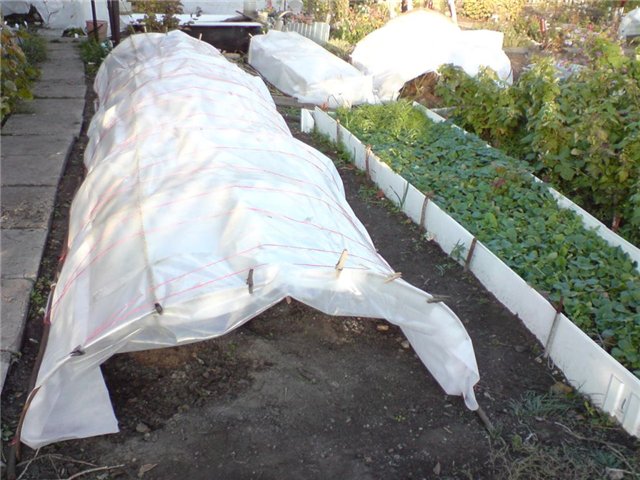
It is important to pay attention to the fact that strawberries are divided into types: long, short, neutral and remontant.
Activities to prepare for winter for long-day strawberries begin at the end of summer, for neutral ones - the end of September. That is, when the leaves grew for the third time, fruit and vegetative buds (from which the mustache grows) took shape.
Renewing and dividing a three-year-old bush
Usually the bush grows greatly in the third year, after which the yield drops. Therefore, such bushes are renewed and planted in the fall. For this purpose they dig old bush. Many side shoots with small roots form around the main bush.
The uterine bush is carefully divided, trying to preserve the young horses as much as possible. The roots of the mother bush are trimmed with pruning shears. Thus, we obtain seedlings for new beds.
Weeding loosening
After removing the mustache and unnecessary leaves, they are removed and burned. Pull out all the weeds. The bushes are hilling. This must be done extremely carefully so as not to damage the roots. A few days before this, you can water the garden bed well.
Treatment and fertilization
Simultaneously with hilling, add phosphorus-potassium fertilizers(20 grams per 1 sq. m.). To do this, hilling is carried out twice. After the first time, spread the fertilizer, the second time mix it with the ground. Fertilizer granules will dissolve gradually and will become a good top dressing for spring. At the same time, they will feed and support the plant in winter.
Some gardeners feed with ash. Add 2 cups of ash to a bucket of water and let it sit for a couple of hours. Pour 0.5 liters per bush. Nitrogen-containing fertilizers are not recommended to be applied at all or in very limited quantities, since they can stimulate development and growth, and we need the growing season to end.
We insulate strawberries for the winter
After the beds are prepared for winter, there is no need to rush to cover them. This is done when the first frosts pass and the ground freezes a few centimeters. Previously covering can only harm the plant. For example, remontant varieties bear fruit almost until the first frost.
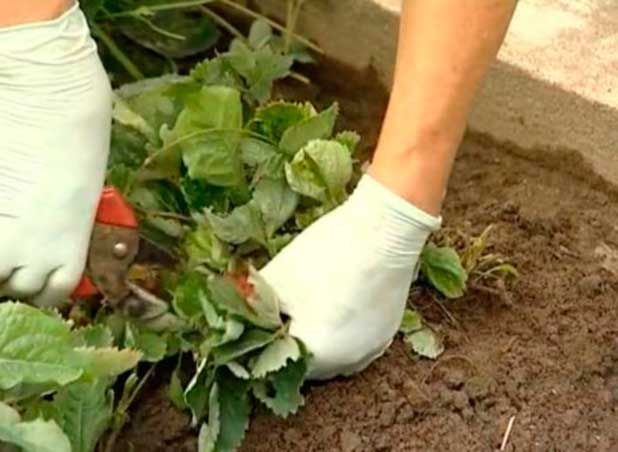
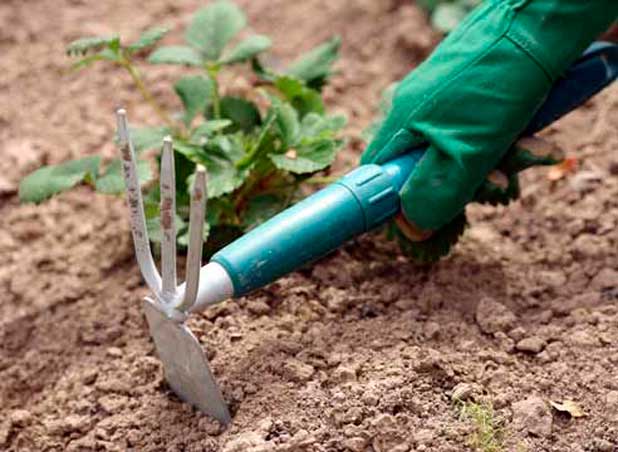


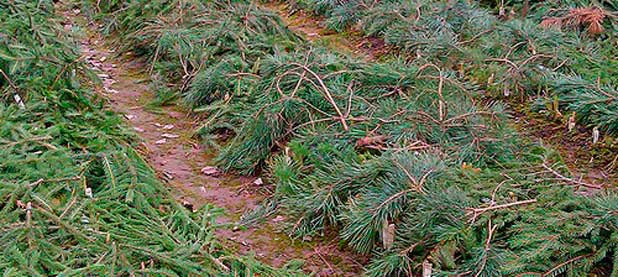
In the middle lane
According to the observations of gardeners and scientists, strawberries tolerate winter well in conditions middle zone, if there is stable snow cover. Therefore, in these latitudes, light shelter is sufficient. When the ground freezes slightly, the beds are covered natural materials. For these purposes, cut branches of grapes, raspberries, and spruce branches are suitable. You can place felled corn stalks between the rows. This will contribute to additional snow retention.

Another method is deep mulching. Use dry leaves, sawdust, peat, and burnt humus. Fruitful and vegetative buds of the plant are formed on a small root collar. It is precisely this that you need to try to insulate as much as possible. In the second and third years, the roots of the plant rise slightly and come to the surface; they also need to be covered. It is not recommended to use foliage fruit trees, so they can introduce diseases into strawberries. You can use walnut, chestnut leaves, and pine needles.
Sawdust
You can also cover strawberries with sawdust for the winter - this is a popular method among gardeners. It is better to use a combined composition, mix sawdust with leaves, add a little humus and peat. Thus, we will cover the peduncle, provide drainage and retain moisture. In the spring, the fertilizer will dissolve and feed the bush, and the sawdust will prevent the growth of weeds.
For northern latitudes, other methods are suitable.

Photo tip
In the Leningrad region
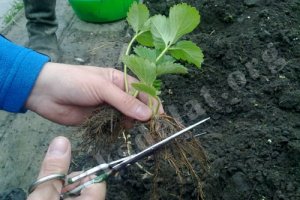 The peculiarity of strawberry shelter in the Leningrad region is that groundwater located in many areas close to the surface, the situation worsens in the spring. Therefore, it is better to make bulk beds for strawberries. Moreover, they retain fertilizers better and are easier to insulate.
The peculiarity of strawberry shelter in the Leningrad region is that groundwater located in many areas close to the surface, the situation worsens in the spring. Therefore, it is better to make bulk beds for strawberries. Moreover, they retain fertilizers better and are easier to insulate.
Winter in the first half is characterized by frequent temperature changes, alternating frosts and thaws. Therefore, snow cover may be unstable. The best way for these latitudes there will be insulation with non-woven covering materials on the frame.
But many people use a combined method of covering, mulching and covering with spruce branches. Mulch with the same composition as described above. When the ground freezes slightly, cover the top of the bed with spruce branches.
Instead of sawdust, peat and humus, you can use pine needles, and then cover them with spruce branches.
In Transbaikalia
This edge is characterized by a long winter period with cold winds and little snow. Temperature ranges from -15 to -37 degrees. That is, conditions that are unfavorable for wintering garden strawberries.
Therefore, the best insulation is an air-dry shelter using agrotextiles. But many gardeners do the following, in order not to risk it, they dig up strawberries. Store in the basement and plant in the spring.
In Siberia
Unlike Transbaikalia, winter in the rest of Siberia is snowy, frosts can drop to -45 degrees. Therefore, even if strawberries are covered with a deep cover of snow for the winter, they can freeze in Siberia. Even if the bushes move away in the spring, the harvest will be worse and there will be fewer berries.
In this region they practice mulching with pine needles and covering with spruce branches. But since the advent of non-woven materials for insulation, many gardeners use an air-dry shelter with a frame. Since the snow cover can reach a depth of up to 2 meters, the frame is made more reliable, for example, from wooden shields.
Covering material
According to experts and reviews from gardeners, the most reliable way to cover wintering strawberries is air-dry insulation using non-woven materials. Unlike film, it has micropores, that is, it allows air to pass through.
The plant thus breathes, reducing the risk of rotting. On the other hand, it retains heat well. Depending on weather conditions You can use agrofibre of different densities and cover it in several layers. After such a wintering, the strawberry yield increases, since garden strawberries experience less stress, wintering in comfortable conditions.
Cover sequence:
- carry out preparatory work as described above;
- mulch the bed;
- install a frame for stretching nonwoven material: arcs, panels, construction metal mesh etc.
- when the ground freezes a few centimeters, that is, the first light frosts have passed, cover with agrofibre.
Depending on climatic conditions selected experimentally optimal type frame and density of non-woven material, preferably not lower than 50 g per square meter.
There are a lot of ways to cover strawberries for the winter, and everyone chooses the one that is most suitable for their region.

